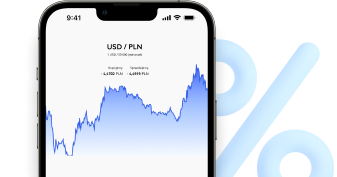Exchange rate CAD - Canadian dollar
The Canadian dollar is the currency of Canada. It is divided into 100 cents.
Select currencies and check rates
Live rates.
Update: 30s
| Currency | Buy | Sell | Name | Currency code |
|---|---|---|---|---|
| CAD PLN | 2.6710 | 2.7226 | Canadian dollar | 1 CAD |
Canadian dollar exchange rate - chart
Last currency comments
Over 900 000 reviews
Customers rate us 4.9/5.0.*
Start saving today
Forget about unfavourable rates and hidden fees. See how much you can save. Create a free account and start converting currency online.
Open account for freeCanadian dollar
The Canadian dollar (CAD) is Canada's official monetary unit and one of the world's most popular currencies. Residents of this country colloquially refer to it as the "loonie". The CAD exchange rate is highly dependent on commodity prices.
The Canadian dollar - where is it used?
The Canadian dollar exchange rate is worth checking when travelling to Canada. Although the CAD is among the 10 most exchanged currencies in the world, it is officially only used in this country. Its symbol is the same as the U.S. dollar - $. For the more straightforward distinction between the two currencies, C$ or even CAD$ is used. Locals refer to it as the "loonie". The name comes from a migratory bird whose image appears on the $1 coin - a common loon or great northern diver.The history of the Canadian dollar
At the turn of the seventeenth and eighteenth centuries, Canada was a currency mess. British pounds, French francs and even Spanish thalers or Portuguese currency were used there. Consequently, it was decided to standardize this, which resulted in the introduction in 1817, initially in parts of the country, of the Canadian dollar, based on the U.S. currency. The Canadian dollar became the official currency of Canada in 1858. The CAD was closely pegged to the U.S. dollar. On the other hand, unrestricted convertibility to gold meant that the Canadian dollar was also stable against other currencies. The CAD covering in gold ore lasted until 1914. Later it was still present between 1926 and 1931, but the Great Depression of the 1930s made it never to return. In the face of these events, Canada also reformed its monetary system and established the Bank of Canada, which was the only bank authorized to issue the Canadian dollar. During World War II, the CAD exchange rate was firmly pegged to other currencies. During the 1950s, the Canadian dollar was pegged and later devalued against the U.S. dollar. Ultimately, however, Canada abandoned the idea of pegging the CAD to other currencies.
The Canadian dollar - key information
The Canadian dollar is subdivided into 100 cents. There are coins in circulation with denominations of 1, 5, 10 and 25 cents, as well as $1 and $2. The obverse of each coin features an image of the current monarch. On the reverse, there are numerous references to the symbols of Canada. The Canadian dollar banknotes come in denominations of 5, 10, 20, 50, 100 and 1000 CAD. The obverse always depicts a politician or a monarch. The reverse refers to the culture, achievements and traditions of this country. It is worth mentioning that Canadian dollars are produced from polymer. Plastic money is more resistant to damage, so it can remain in circulation longer. They are also more difficult to counterfeit.
What determines the Canadian dollar conversion rate?
The Canadian dollar exchange rate is perceived as relatively stable. This has to do with Canada's good political and economic situation. For this reason, the CAD is often seen as a reasonable reserve currency. Many factors influence the CAD exchange rate (e.g. the CAD to EUR, the CAD against USD). These include the prices of commodities such as oil, natural gas, gold, nickel, cobalt and copper. These are Canada's main export goods. Due to the country's location, CAD can also respond to U.S. economic decisions and changes in the U.S. dollar, among other things.






























